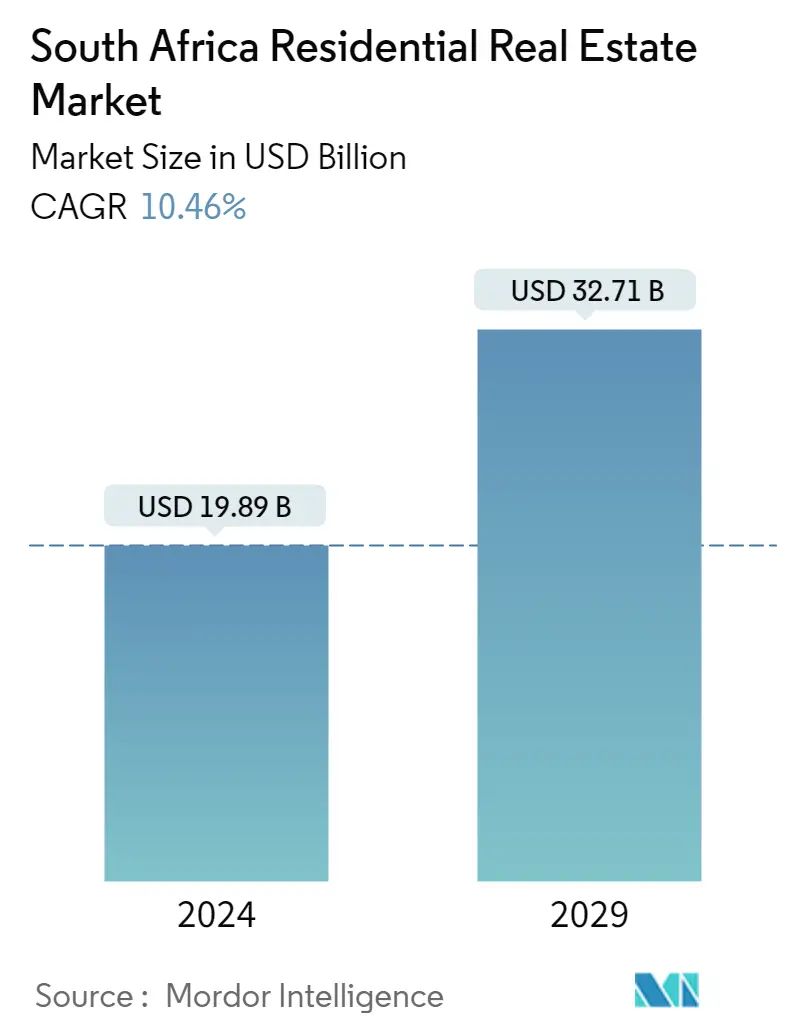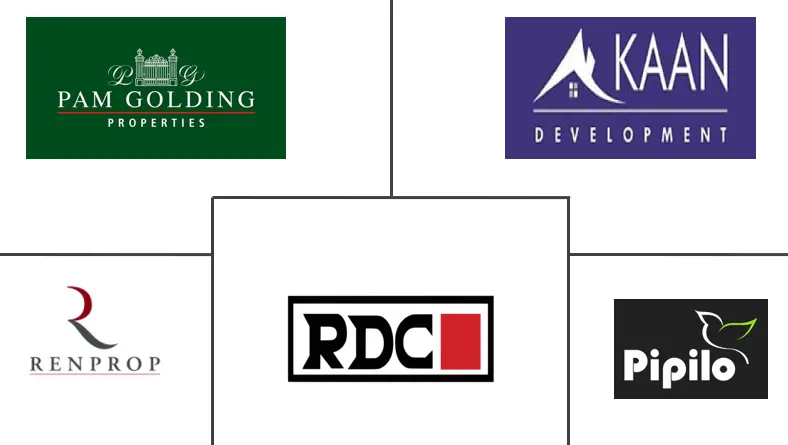Market Size of South Africa Residential Real Estate Industry

| Study Period | 2020 - 2029 |
| Base Year For Estimation | 2023 |
| Market Size (2024) | USD 19.89 Billion |
| Market Size (2029) | USD 32.71 Billion |
| CAGR (2024 - 2029) | 10.46 % |
| Market Concentration | Low |
Major Players
*Disclaimer: Major Players sorted in no particular order |
South Africa Real Estate Market Analysis
The South Africa Residential Real Estate Market size is estimated at USD 19.89 billion in 2024, and is expected to reach USD 32.71 billion by 2029, growing at a CAGR of 10.46% during the forecast period (2024-2029).
Despite the uncertainties surrounding COVID-19 and the subsequent lockdowns, the residential property market has become one of South Africa's more robust sectors.
- The country's demographics show that 15.6 million South Africans are aged 20 to 34. With the right economic opportunities, many first-time buyers are entering the market. Others who already have a home are discovering property's potential to create wealth. The good news for new investors is that interest rates are favourable, and the current slow rental growth will likely improve over time. Several factors have fuelled the housing market, like low-interest rates, the rise of working-from-home trends, and the appeal of more space in the event of lockdowns are among them.
- The slow recovery in the labour market, combined with rising interest rates, suggests a less supportive medium-term environment for home-buying activity. However, if sustained, the ongoing shifts in housing needs, which have lent support to homeownership, could mitigate the impact. Residential real estate in South Africa can cost up to 1.6 million South African rands on average, depending on location. One of South Africa's three capital cities and the second-largest metropolis in the nation after Johannesburg, Cape Town is located in the West Cape province.
- Even though housing prices in Johannesburg were reduced, they were still above the one million South African rand threshold. Even though costs vary greatly based on location and property type, the majority of residential property deals cost over 1.2 million South African rands. This was a little bit more than what was typical for mortgage loans to first-time buyers. In terms of the rental market, Mpumalanga saw the greatest growth in rents, but the Western Cape saw the highest rents.
South Africa Real Estate Industry Segmentation
Residential real estate is an area developed for people to live in. As defined by local zoning ordinances, residential real estate cannot be used for commercial or industrial purposes. A complete background analysis of the South Africa Residential Real Estate Market, including the assessment of the economy and contribution of sectors in the economy, market overview, market size estimation for key segments, and emerging trends in the market segments, market dynamics, and geographical trends, and COVID-19 impact is included in the report.
The South Africa Residential Real Estate Market is segmented By Type (Villas and Landed Houses, Condominiums, and Apartments) and By city (Johannesburg, Cape Town, Durban, Port Elizabeth, Bloemfontein, Pretoria, and the Rest of South Africa). The report offers the market size and forecasts in values (USD billion) for all the above segments.
| By Type | |
| Villas and Landed Houses | |
| Condominiums and Apartments |
| By Key Cities | |
| Johannesburg | |
| Cape Town | |
| Durban | |
| Port Elizabeth | |
| Bloemfontein | |
| Pretoria | |
| Rest of South Africa |
South Africa Residential Real Estate Market Size Summary
The South African residential real estate market is experiencing a period of growth, driven by favorable interest rates and changing housing needs. Despite challenges such as the slow recovery in the labor market and rising interest rates, the market remains resilient, with first-time buyers and existing homeowners recognizing the potential for property to generate wealth. The trend towards working from home and the desire for more space have further fueled demand. The market is characterized by a shift towards sectional title and estate homes, offering increased security and affordability, which are appealing to many buyers. Areas like Midrand have seen significant growth in sectional title properties, highlighting the popularity of this ownership model among first-time homebuyers.
The market landscape is fragmented, with key players like Pam Golding Properties and RE/MAX of Southern Africa leading the sector. While property development continues, challenges such as oversupply and high vacancy rates persist, particularly in the rental market. The Western Cape remains the most expensive province for rentals, with Gauteng showing signs of recovery in rental growth. Initiatives to improve access to affordable housing, such as investments by the International Finance Corporation, are underway to address housing shortages. Overall, the South African residential real estate market is navigating a complex environment, balancing growth opportunities with economic and market challenges.
South Africa Residential Real Estate Market Size - Table of Contents
-
1. MARKET INSIGHTS
-
1.1 Current Economic Scenario and Consumer Sentiment
-
1.2 Market Dynamics
-
1.2.1 Drivers
-
1.2.2 Restraints
-
1.2.3 Opportunities
-
-
1.3 Industry Attractiveness - Porter's Five Forces Analysis
-
1.3.1 Bargaining Power Of Suppliers
-
1.3.2 Bargaining Power Of Buyers/Consumers
-
1.3.3 Threat Of New Entrants
-
1.3.4 Threat Of Substitute Products
-
1.3.5 Intensity Of Competitive Rivalry
-
-
1.4 Residential Real Estate Buying Trends - Socioeconomic and Demographic Insights
-
1.5 Government Initiatives and Regulatory Aspects for the Residential Real Estate Sector
-
1.6 Insights into Size of Real Estate Lending and Loaning to Value Trends
-
1.7 Insights into Interest Rate Regime for General Economy and Real Estate Lending
-
1.8 Insights into Rental Yields in the Residential Real Estate Segment
-
1.9 Insights into the Capital Market Penetration and REIT Presence in Residential Real Estate
-
1.10 Insights into Real Estate Tech and Startups Active in the Real Estate Segment (Broking, Social Media, Facility Management, and Property Management)
-
1.11 Insights into Affordable Housing Support Provided by Government and Public-private Partnerships
-
1.12 Insights on Residential Real Estate by Price Segment
-
1.13 Insights on Residential Real Estate by Province (Gauteng, Western Cape, KwaZulu-Natal, Eastern Cape, and Rest of South America)
-
1.14 Impact of COVID-19 on the market
-
-
2. MARKET SEGMENTATION
-
2.1 By Type
-
2.1.1 Villas and Landed Houses
-
2.1.2 Condominiums and Apartments
-
-
2.2 By Key Cities
-
2.2.1 Johannesburg
-
2.2.2 Cape Town
-
2.2.3 Durban
-
2.2.4 Port Elizabeth
-
2.2.5 Bloemfontein
-
2.2.6 Pretoria
-
2.2.7 Rest of South Africa
-
-
South Africa Residential Real Estate Market Size FAQs
How big is the South Africa Residential Real Estate Market?
The South Africa Residential Real Estate Market size is expected to reach USD 19.89 billion in 2024 and grow at a CAGR of 10.46% to reach USD 32.71 billion by 2029.
What is the current South Africa Residential Real Estate Market size?
In 2024, the South Africa Residential Real Estate Market size is expected to reach USD 19.89 billion.

